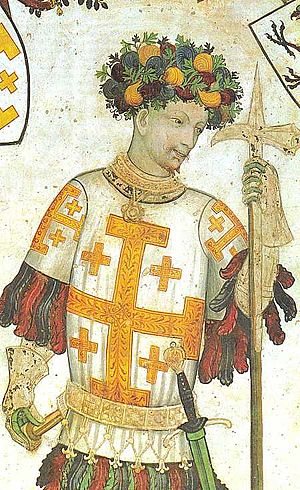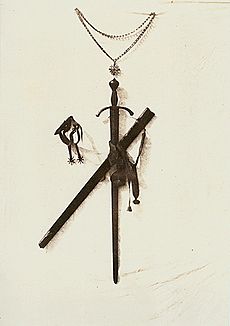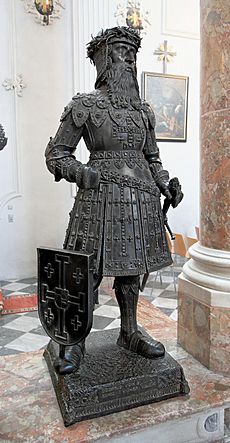Godfrey of Bouillon facts for kids
Quick facts for kids Godfrey of Bouillon |
|
|---|---|

Godfrey of Bouillon, from a fresco painted by Giacomo Jaquerio in Saluzzo, northern Italy, around 1420
|
|
| Defender of the Holy Sepulchre | |
| Reign | 22 July 1099 – 18 July 1100 |
| Successor | Baldwin I (as King of Jerusalem) |
| Duke of Lower Lorraine | |
| Reign | 1089 – 1096 |
| Predecessor | Conrad |
| Successor | Henry I |
| Born | c. 1060 Boulogne, Kingdom of France |
| Died | 18 July 1100 (aged 39–40) Jerusalem, Kingdom of Jerusalem |
| Burial | Church of the Holy Sepulchre |
| House | House of Flanders |
| Father | Eustace II of Boulogne |
| Mother | Ida of Lorraine |
| Religion | Catholicism |
Godfrey of Bouillon (born around 1060 – died July 18, 1100) was an important French nobleman. He was one of the main leaders of the First Crusade. From 1099 to 1100, he was the first ruler of the Kingdom of Jerusalem. He chose not to use the title of king. Instead, he preferred to be called princeps (prince) or "defender of the Holy Sepulchre".
Godfrey was the second son of Eustace II, Count of Boulogne. He became the Lord of Bouillon in 1076. Later, he gained control of the Duchy of Lower Lorraine in 1087. This was a reward for his loyalty to the Holy Roman Emperor Henry IV.
In 1096, Godfrey joined the First Crusade with his brothers Eustace and Baldwin. He fought in battles at Nicaea, Dorylaeum, and Antioch. He played a very important part in the successful Siege of Jerusalem in 1099. After the city was captured, Raymond of Toulouse was offered the chance to become king but refused. Godfrey accepted the leadership. He famously said he would not wear "a crown of gold" where Jesus Christ had worn "a crown of thorns". Godfrey secured his new kingdom by defeating the Fatimids at the Battle of Ascalon a month later. This battle marked the end of the First Crusade.
Godfrey ruled Jerusalem for only one year before he died in 1100. His brother Baldwin took over and became the first King of Jerusalem.
Contents
Early Life and Challenges
Godfrey of Bouillon was born around 1060. His father was Eustace II, Count of Boulogne. His mother was Ida, whose father was Duke Godfrey the Bearded. He was likely born in Boulogne-sur-Mer, France.
As a second son, Godfrey did not expect to inherit much land. However, his uncle, Godfrey the Hunchback, died without children. He named Godfrey of Bouillon as his heir. This meant Godfrey would inherit the important Duchy of Lower Lorraine. This duchy was a key area between France and the German lands.
The German king, Henry IV, saw Lower Lorraine as very important. In 1076, he decided to give the duchy to his own son. He only gave Godfrey the smaller areas of Bouillon and the Margraviate of Antwerp. This was a test of Godfrey's loyalty. Godfrey served Henry IV faithfully. He even supported him during a conflict with Pope Gregory VII.
Godfrey faced many challenges to keep his inheritance. His aunt, cousin, and several counts tried to take parts of his land. His brothers, Eustace and Baldwin, helped him fight these enemies. After many struggles, Godfrey finally won back his Duchy of Lower Lorraine in 1087. His role in the First Crusade later made him much more famous.
The First Crusade

In 1095, Pope Urban II called for a Crusade. The goal was to free Jerusalem from Muslim control and help the Byzantine Empire. Godfrey took out loans or sold most of his lands to raise money. He gathered thousands of knights to fight in the Holy Land. His older brother Eustace and younger brother Baldwin joined him.
Other noblemen also gathered armies. Raymond IV, Count of Toulouse, had the largest army. He was 55 years old and expected to lead the entire Crusade. Bohemond, a Norman knight, led another group. Robert II, Count of Flanders, led a fourth.
Each army traveled separately across Europe. Before the main armies, groups of peasants and lower-ranking knights set off early in 1096. This was known as the People's Crusade. They caused harm to Jewish communities during the Rhineland massacres. Godfrey and his brothers started their journey in August 1096. They led an army of many thousands from Lorraine. They arrived in Constantinople, the capital of the Byzantine Empire, in November. The Pope had called the Crusade to help the Byzantine emperor, Alexius I, fight the Islamic Turks.
Godfrey and his troops were the second Crusader army to reach Constantinople. Over the next few months, other Crusader armies arrived. Emperor Alexius I wanted the Crusaders to help him get back lands taken by the Seljuk Turks. The Crusaders, however, mainly wanted to free the Holy Land in Palestine from Muslim rule. Alexius I expected the Crusaders to promise loyalty to him. Godfrey and the other knights agreed to a modified oath. They promised to help return some lands to Alexius I. By spring 1097, the Crusaders were ready to march into battle.
Battles for Nicaea and Antioch
The Crusaders' first big victory was at the city of Nicaea. The Seljuk Turks had captured it in 1085. Godfrey and his knights played a smaller role in the siege of Nicaea. Bohemond led much of the fighting. Just as the Crusaders were about to attack the city, they saw the Byzantine flag on the walls. Alexius I had secretly made peace with the Turks and claimed the city for his empire. This secret deal showed the growing tension between the Crusaders and the Byzantines.
Godfrey continued to play an important role in battles against the Muslims. In 1098, Godfrey helped capture Antioch. This city fell in June after long and difficult fighting. During the siege, some Crusaders lost hope and left to return to Europe. Alexius I, hearing of the tough situation, thought Antioch was lost. He did not send help as he had promised. When the Crusaders finally took the city, they felt their oaths to Alexius were no longer valid. Bohemond claimed Antioch for himself. A Muslim army from Mosul arrived and fought the Crusaders, but the Christians won.
March to Jerusalem
After the victory at Antioch, the Crusaders disagreed on what to do next. Most of the foot soldiers wanted to go south to Jerusalem. But Raymond IV of Toulouse, who was now very powerful, hesitated. After months of waiting, the common soldiers forced Raymond to march on Jerusalem. Godfrey quickly joined him.
As they traveled south into Palestine, the Crusaders met a new enemy. The Fatimids, a North African Muslim group, now ruled these lands. The Fatimids had taken Jerusalem in August 1098. The Crusaders would have to fight them for the final prize of the First Crusade: the city of Jerusalem.
The army reached Jerusalem in June 1099. They built a large wooden siege tower to get over the city walls. The main attack happened on July 14 and 15, 1099. Godfrey and some of his knights were among the first to climb the walls and enter the city. This ended three years of fighting for the Crusaders. They had finally achieved their goal: to recapture the Holy Land and especially Jerusalem, with its holy sites like the Holy Sepulchre, the empty tomb of Jesus Christ.
Ruler of Jerusalem
After Jerusalem was under Christian rule, a new government was needed. On July 22, a meeting was held in the Church of the Holy Sepulchre. Raymond of Toulouse refused to become king. Godfrey agreed to become the ruler.
Godfrey refused to be crowned king. He believed he should not wear "a crown of gold" where his Saviour had worn "a crown of thorns". The exact title he used is debated. Many say he took the title Advocatus Sancti Sepulchri ("defender" of the Church of the Holy Sepulchre). However, he may have simply used Princeps (prince) or kept his old title of dux (duke).
During his short rule, Godfrey had to defend the new Kingdom of Jerusalem. He defeated the Fatimids of Egypt at the Battle of Ascalon in August. He also faced challenges from Dagobert of Pisa, the Latin Patriarch of Jerusalem. Godfrey's actions prevented the capture of Ascalon, which remained a problem for the new kingdom.
In 1100, Godfrey could not expand his lands much through conquest. However, his victory in 1099 and later campaigns forced cities like Acre, Ascalon, Arsuf, Jaffa, and Caesarea to pay him tribute. Godfrey died in 1100. His supporters quickly made sure his brother Baldwin would take over. Dagobert was then forced to crown Baldwin as the first Latin king of Jerusalem on December 25, 1100.
Death
Some Arab historians say Godfrey died from an arrow wound while besieging the city of Acre. However, Christian historians do not mention this. Instead, they report that Godfrey became ill in Caesarea in June 1100 and died in Jerusalem. There was a rumor that the emir of Caesarea poisoned him, but there is no strong evidence for this. It is also said he died after eating a poisoned apple. Godfrey never married.
Legacy and Fame

Later writers often saw Godfrey of Bouillon as a perfect hero. He was shown as the main leader of the Crusades and the king of Jerusalem. He was even included among the Nine Worthies, a group of ideal knights. In reality, Godfrey was one of several important leaders. His younger brother, Baldwin I of Jerusalem, became the first official king of Jerusalem after Godfrey died.
Godfrey's story was told in many French poems and songs called chansons de geste. These stories linked his family to the legend of the Knight of the Swan, which is famous today from Wagner's opera Lohengrin.
By the 12th century, Godfrey was already a legend. People believed he had amazing physical strength. It was said he once wrestled a bear in Cilicia and won.
Today, an equestrian statue of Godfrey of Bouillon stands in the center of the Royal Square in Brussels, Belgium. It was unveiled on August 24, 1848.
Godfrey is also a key figure in some modern theories found in books like The Holy Blood and the Holy Grail and The Da Vinci Code. In 2005, he was voted 17th in a public poll for the greatest Belgian in the French language.
Godfrey in Literature and Music
- In his famous poem Divine Comedy, Dante Alighieri places Godfrey's spirit in the Heaven of Mars. He is there with other "warriors of the faith."
- Torquato Tasso made Godfrey the hero of his epic poem Jerusalem Delivered.
- A Spanish play from the 1580s, "La conquista de Jerusalén por Godofre de Bullón", is believed to be written by Miguel de Cervantes. It shows Godfrey as an ideal Christian ruler.
- Godfrey appears as "Goffredo" in Georg Friedrich Händel's opera Rinaldo (1711).
- He is also a character in several novels, including The Blue Gonfalon by Margaret Ann Hubbard and The Iron Lance by Stephen R. Lawhead.
Images for kids
-
Godfrey with his brothers Eustace and Baldwin meeting with Byzantine emperor Alexios I Komnenos
See also
 In Spanish: Godofredo de Bouillón para niños
In Spanish: Godofredo de Bouillón para niños







